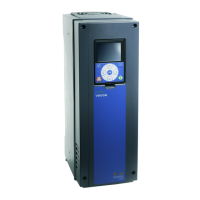EtherNet/IP vacon • 18
24-hour support +358 (0)201 212 575 • Email: vacon@vacon.com
6
6. ETHERNET/IP
6.1 Overview
The EtherNet/IP (Ethernet/Industrial Protocol) is a communication system suitable for use in
industrial environments. The EtherNet/IP allows industrial devices to exchange time-critical
application information. These devices include simple I/O devices such as sensors/actuators, as
well as complex control devices such as robots, programmable logic c ontrollers, welders, and
process controllers.
The EtherNet/IP uses CIP (Control and Information Protocol), the common network, transport and
application layers also shared by ControlNet and EtherNet/IP. The EtherNet/IP then makes use of
standard Ethernet and TCP/IP technology to transport CIP communications packets. The result is a
common, open application layer on top of open and highly popular Ethernet and TCP/IP protocols.
The EtherNet/IP Messaging Forms:
• Unconnected Messaging is used for connection establishment and for infrequent, low prior-
ity messages.
• Connected Messaging utilizes resources which are dedicated in advance to a particular pur-
pose such as real-time I/O data transfer. EtherNet/IP Messaging Connections.
• Explicit Messaging Connections are general purpose point-to-point connections. Messages
are sent through the TCP protocol.
• Implicit (I/O Data) Connections are established to move application specific I/O Data at regu-
lar intervals. They are often set up as one-to-many relationships in order to take full advan-
tage of the producer-consumer multicast model. Implicit messages are sent through the
UDP protocol.
6.2 AC/DC Drive Profile
VACON® 100 Family AC drives implement the CIP AC/DC drive profile.
In order to provide interoperability between devices from different manufacturers, there must be a
defined "standard" in which those devices:
• exhibit the same behaviour
• produce and/or consume the same basic set of I/O data
• contain the same basic set of configurable attributes. The formal definition of this
information is known as a device profile.
6.3 EDS file
You can provide configuration support for your device by using a specially formatted ASCII file, re-
ferred to as the EDS (Electronic Data Sheet). An EDS provides information about the device config-
uration.
The information in an EDS allows configuration tools to provide informative screens that guide a
user through the steps necessary to configure a device. An EDS provides all of the information nec-
essary to access and alter the configurable parameters of a device.
You can download the EDS for VACON® 100 Family AC drives from Danfoss website (http://
drives.danfoss.com).

